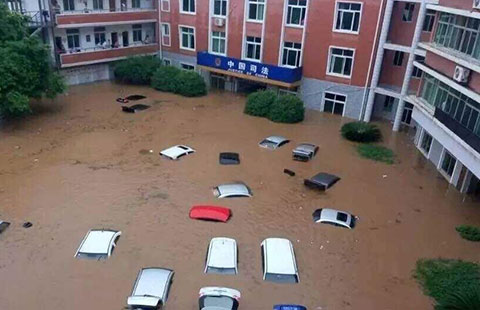
El Nino threatens Africa's food security once more
Vivid memories of the 2011 drought and famine in the Horn of Africa, the worst in 60 years, is a reminder that climate change continues to play a decisive role in Africa's food security. The damage is unlikely to abate, especially with the threat of a new round of the El Nino weather phenomenon.
Adam Scaife, a professor at the UK Met Office Hadley Centre, says El Nino will have a serious effect in Africa, especially in the Horn and Sahel regions.

|
A woman fetches drinking water from a well along the dry Chemumvuri riverbed near Gokwe, Zimbabwe, on May 20. Provided to China Daily |
|
A Zimbabwean man harvests maize from a field in a suburb in Harare. Provided to China Daily |
"The Greater Horn of Africa has two rainy seasons, spring and autumn. The autumn rains are closest to the winter peak of El Nino, and it tends to be wetter then during El Nino and drier during La Nina," he says. "As El Nino is now growing strongly, it is affecting the risk of drought and heavy rainfall across Africa. There is now an increased chance of wetter than average conditions later in the year in parts of the Greater Horn of Africa."
El Nino occurs when warm water moves from the western to the eastern equatorial Pacific Ocean, in conjunction with a change in prevailing trade winds. It is a natural phenomenon that occurs irregularly every two to seven years and can last from nine months to a few years. El Nino episodes cause deviations in normal ocean surface temperatures, resulting in a significant effect on global weather systems as heat transfers from the oceans into the atmosphere, changing temperatures and rainfall patterns. These in turn cause droughts, storms, forest fires and floods, depending on the location.
Scaife says it is too early to say what will happen with seasonal Sahel rainfall, but the monsoon onset has occurred. However, forecasts continue to suggest an increased risk of a drier than normal season.
"A similar dry signal is also seen in India as we reported earlier this year. Indian monsoon rainfall to date is below average."
He says that, under the effect of El Nino and climate change, rainfall strongly influences African agriculture. Diseases spread by mosquitoes, such as malaria, are also influenced because standing water is needed for the insects' life cycle.
The South African Weather Service says that while the southern part of Africa generally receives below-normal rainfall during El Nino years and that La Nina usually brings normal or above-normal rainfall, it cannot be accepted as a rule.
"For example, the 1997-1998 El Nino was the strongest on record, but not all of South Africa received below-normal rainfall," the South African weather authority has said.
The National Drought Mitigation Center of South Africa says El Nino has typically caused intense drought in parts of eastern and southern Africa, Australia, India, Indonesia, the Philippines, Brazil, the western Pacific basin islands and parts of the United States.
"Eastern and southern Africa also showed a strong correlation between ENSO (El Nino Southern Oscillation) events and a lack of rainfall that brings on drought in the Horn region and areas south of there," the center says.
ENSO is described as the seesawing of atmospheric pressure between the eastern equatorial Pacific and Indo-Australian areas.
This kind of climate change has had a noticeable impact on Africa in recent years, and the worst is the drought that has seriously threatened the continent's food security, according to Li Xiaoyun, a professor at the Chinese Agricultural University.
"Most parts of the continent lie in the tropical area and to a large extent are affected by the rainy season. But in recent years, its rainy season has been as regular as before and rainfall volume has decreased largely," he says.
This kind of irregularity has challenged Africa's traditional agricultural methods, which are more natural with regular weather conditions. African farming also suffers from a serious lack of irrigation, so the whole agricultural system has been unable to adapt to climate change, says Li.
"Africa's irrigation area is less than 9 percent of its total land, and the number can be as low as 3 or 5 percent in many countries," he says. "So it becomes more difficult to deal with climate change and drought."
In Ethiopia, rainfall patterns are highly complex due to the varied topography of the country. Seasonality, duration, and regularity of rainfall vary by both latitude and longitude, but ENSO cycles affect it. According to a report from the United Nations World Food Programme, chances for flooding in Ethiopia during the short rainy season (October-December) are higher with El Nino events, while La Nina events are associated with higher probabilities of drought.
"Annual rainfall patterns in Ethiopia and more generally in the Greater Horn of Africa are linked with regional sea surface temperatures in the Indian Ocean: warmer Indian Ocean SSTs are linked to dryness. Variability in the strength of warming of the Indian Ocean strongly influences precipitation totals in Ethiopia and accounts for important climatological phenomena such as the decline in rainfall between the 1960s and 1980s, especially in the western parts of Ethiopia, and the devastating drought of 1984," the report says.
It also says that these climate trends are consistent with community perceptions of risk.
"According to research by the Africa Climate Change Resilience Alliance, weather-related hazards are perceived by communities to be the main risks affecting their livelihoods and food security. In particular, erratic or decreasing rains are seen as the key risks at the community level," the report says. "Observed climatic changes have had negative impacts on both cropping and pastoral areas. Recent trends in rainfall performance in crop growing areas suggest increasingly dry conditions across several regions."
Africa should focus more on improving its irrigation system while upgrading its agricultural system in general to better address challenges of severe climate change, Li from the Chinese Agricultural University says.
"International aid and domestic policy preference should also be given to this area," he adds.
To better combat the negative effects of climate change, the Climate Services for Action Africa Project in Tanzania and Malawi was launched by the WFP. It is a multi-partner pilot program to provide improved weather and climate information to help better manage the climate risks to health and food security.

Through this project, the WFP is providing tailored weather and climate information to farmers to help them enhance their agricultural or livestock production through radio, cell phones and other methods. The pilots in Malawi and Tanzania will serve as models for how different organizations can work together to design and implement comprehensive climate services in the humanitarian and development sectors.
The El Nino weather phenomenon is also rearing its ugly head again in South Asia, despite reasonably good monsoon rains, raising fears of significant crop losses, increased food prices and rising inflation.
Meteorological agencies in Japan, Australia and the United States have all voiced concerns that this year's El Nino will not go away quickly, as was the case in 2014.
All three agencies fear El Nino will last longer and intensify during the second half of the year and probably well into 2016. Just how severe it will be remains to be seen.
The west coast of the Americas, for example, experiences more rain, while Indonesia and Australia battle severe drought. The broader impacts are global and can have much wider effects.
The last major El Nino (1997-98) led to 23,000 deaths and caused economic damage globally of around $35 billion, according to the US-based National Oceanic and Atmospheric Administration.
The problem facing Asian governments and economic planners is trying to estimate what this weather phenomenon will mean for food prices and inflation.
Joseph Incalcaterra, an economist with HSBC in Hong Kong, says in a note that the risks from El Nino should not be "underestimated", and that the latest updates from the world's principal meteorological agencies have made clear that there are no signs of El Nino conditions subsiding, as was the case last summer.
"To the contrary, the language implies that El Nino conditions will last longer and possibly intensify," Incalcaterra says.
Graeme Hammer, professor of crop science at the University of Queensland in Brisbane, says the latest modeling showed El Nino will have a "significant impact" on wheat yields in Australia, the world's fifth-largest producer of the crop.
"It's not looking great," he says.
According to the Australian Bureau of Agricultural and Resource Economics and Sciences, Australia's wheat harvest for 2015-16 could be cut by more than 1 million tons.
"It's really difficult to predict the effect of an El Nino this early," Peter Collins, manager for agricultural commodities at the bureau, told Bloomberg.
The Food and Agriculture Organization of the United Nations predicts El Nino could cut global wheat output by 1.4 percent.
Gundy Cahyadi, an economist with DBS Bank in Singapore, says the most immediate impact of El Nino will be felt in agriculture, but the full impact will be felt "through the inflation channel".
Food makes up 30 to 40 percent of the consumer price index basket in countries like Thailand, the Philippines and Indonesia, Cahyadi tells China Daily.
"Higher food prices will clearly put upward pressure on inflation," he says. "Of the three countries we cover - Thailand, the Philippines and Indonesia - we are probably more worried about Indonesia at this juncture, given that inflationary expectations there have been relatively higher.
"The weak rupiah has also been a factor," Cahyadi adds.
"When you look at the economy, with signs of moderation in domestic demand, the last thing the economy needs is prices shooting up in 2016."
While DBS has not factored in the impact of El Nino in its forecasts, he adds. "We are monitoring developments".
Mark Walton, a Hong Kong-based economist with French bank BNP Paribas, says anything that pushes food prices materially higher in Asia "has the potential to be a headache for central banks".
A study by the International Monetary Fund has found El Nino adds between 0.5 and 0.9 percentage points to inflation in India, Indonesia and Thailand. Food prices in these countries make up 48 percent, 33 percent and 34 percent of their respective inflation baskets.
But Rajiv Biswas, Asia-Pacific chief economist with IHS Consulting, is less pessimistic. He says fears about the impact of El Nino on Asian agricultural production have eased due to better-than-expected rainfall, especially in India, where monsoon rains in June were better than forecast.
"It is hard to predict the full impact of El Nino," he tells China Daily. "If we do get a severe El Nino later in the year, it could impact the production of key commodities such as coffee and palm oil in Southeast Asia. If that situation occurs, it could push up certain soft commodity prices. But it is still early days."
In a report in June, the Food and Agriculture Organization says while international forecasters have acknowledged the arrival of El Nino, its full impact sometime toward the end of the year "will depend on the severity/duration of the phenomenon".
Indonesia is said to be watching the development of El Nino closely, anticipating its direct impact on the country's production of agricultural crops including rice, palm oil, coffee, corn and cassava.
Rice is a key commodity in Indonesia and the staple food of nearly all households. A solid rice output is important to combat poverty.
However, the nation's production can barely meet domestic demand, even in optimal climate conditions, says the website Indonesia Investments.
The US Department of Agriculture predicts Indonesia needs to import at least 1.5 million tons of rice in 2015 as there are no other short-term solutions. However, due to the weak rupiah, this may bring imported inflation.
The Association of Indonesian Coffee Exporters and Producers estimates that Indonesian coffee output will be between 600,000 and 650,000 tons this year, lower than the institution's earlier forecast of 650,000 to 700,000 tons, and below production last year of 711,513 tons.
Other analysts and industry groups expect the El Nino phenomenon will reduce the forecast by about 50,000 tons.
Indonesia is the world's third-largest producer of the robusta species of coffee bean, which, according to a report from HSBC, is highly vulnerable to a lack of rainfall.
In Vietnam, the world's largest robusta bean grower, dry weather has already triggered concerns about coffee output as more hot spells are expected.
Starbucks says in a written reply that it was closely monitoring coffee production in the region, but it would be difficult to evaluate the impact of El Nino at this point. According to logistics provider Damco, Vietnam and Indonesia are important sources for Starbucks.
The Philippines has placed eight provinces under a state of calamity due to a drought blamed on El Nino. Farmers say 40 percent of their crops have been affected by the drought, and could lessen their crop production for the rest of the year.
Meteorologists say more than 50 of the 81 provinces in the Philippines were beginning to suffer from the effects of the El Nino phenomenon.
Chua Hak Bin, an economist with the Bank of America Merrill Lynch, cautioned that Asian central banks faced "risks and uncertainty" from the El Nino phenomenon, with "potential severe weather shocks on growth".
In the three quarters following an El Nino occurrence, inflation tends to spike 1 percent in Indonesia, 0.6 percent in India and 0.5 percent in Thailand, Chua told CNBC.
"That may narrow the room for easing monetary policy and cutting interest rates," he says.
Contact the writers through leolilianxing@chinadaily.com.cn
|
Children are engulfed in dust in Bangui in the Central African Republic. Provided to China Daily |
|
Firefighters evacuate a sick woman in a flooded area at Riviera Bounoumin in Abidjan, Cote d'Ivoire. Provided to China Daily |
(China Daily Africa Weekly 07/24/2015 page1)








